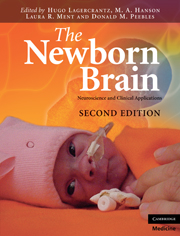Book contents
- Frontmatter
- Contents
- List of contributors
- Preface to the First Edition
- Preface to the Second Edition
- 1 Reflections on the origins of the human brain
- Section 1 Making of the brain
- 2 The molecular basis of central nervous system development
- 3 Holoprosencephaly and microcephaly vera: perturbations of proliferation
- 4 Neuronal migration
- 5 The neonatal synaptic big bang
- 6 Neurotrophic factors in brain development
- 7 Neurotransmitters and neuromodulators
- 8 Glial cell biology
- Section 2 Sensory systems and behavior
- Section 3 Radiological and neurophysiological investigations
- Section 4 Clinical aspects
- Section 5 Follow-up
- Section 6 Consciousness
- Index
- Plate section
- References
8 - Glial cell biology
from Section 1 - Making of the brain
Published online by Cambridge University Press: 01 March 2011
- Frontmatter
- Contents
- List of contributors
- Preface to the First Edition
- Preface to the Second Edition
- 1 Reflections on the origins of the human brain
- Section 1 Making of the brain
- 2 The molecular basis of central nervous system development
- 3 Holoprosencephaly and microcephaly vera: perturbations of proliferation
- 4 Neuronal migration
- 5 The neonatal synaptic big bang
- 6 Neurotrophic factors in brain development
- 7 Neurotransmitters and neuromodulators
- 8 Glial cell biology
- Section 2 Sensory systems and behavior
- Section 3 Radiological and neurophysiological investigations
- Section 4 Clinical aspects
- Section 5 Follow-up
- Section 6 Consciousness
- Index
- Plate section
- References
Summary
Neuronal–glial interaction in nutrition and amino-acid-mediated neurotransmission
Nutrition
The main substrate for brain energy metabolism is glucose, and in the adult human brain the glucose consumption, termed cerebral metabolic rate for glucose (CMRgluc), is around 20 µmol/h per g wet weight (Sokoloff,1960). Alternative substrates may, however, be used and in this regard ketone bodies may have an important role particularly in the infant brain. The unique anatomical location of astrocytes, that is with their end-feet closely apposed to the capillaries (Fig. 8.1), has led to the proposal (Pellerin & Magistretti, 1994; Magistretti & Pellerin, 1996) that astrocytes may be the major site for uptake of glucose in the brain. As glucose will be rapidly converted into glucose 6-phosphate, which cannot cross the cell membrane, it is likely that metabolism of glucose proceeds to form lactate, which may subsequently be transferred from the astrocytes to the neurons via the monocarboxylic acid transporters present in the membranes of both types of brain cell (Fig. 8.1) and possibly most prevalent in neurons (Pellerin et al., 1998). The lactate concentration is augmented in the brain subsequent to stimulation; however, evidence for a subsequent net oxidation in the adjacent neurons is lacking (Hertz et al., 2007). Interestingly, as determined by microdialysis, astrocytes and neurons oxidize 50% each of the interstitial lactate in freely moving rats (Zielke et al., 2007).
- Type
- Chapter
- Information
- The Newborn BrainNeuroscience and Clinical Applications, pp. 121 - 128Publisher: Cambridge University PressPrint publication year: 2010



